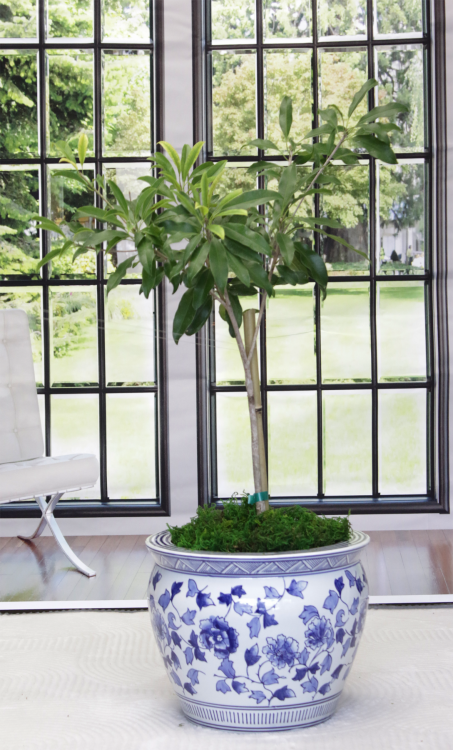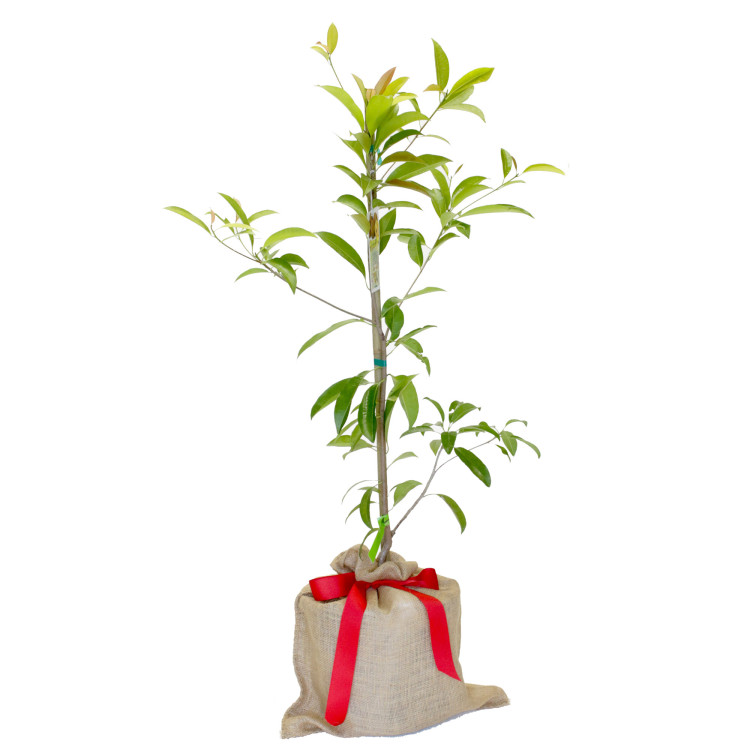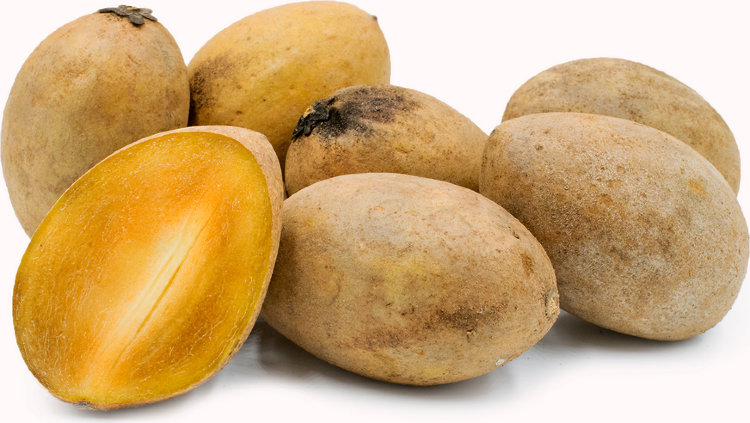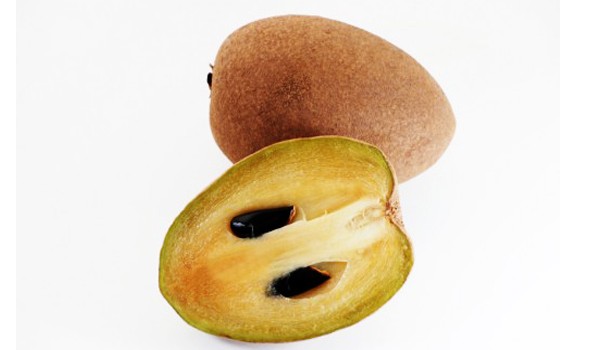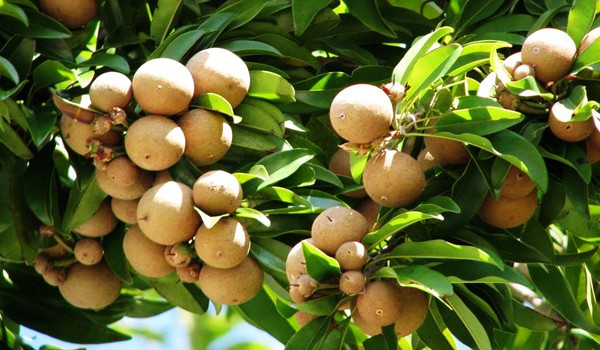- Overview
Common name: Sapodilla, Naseberry, Nispero, Sapote Botanical name: Manilkara zapota Family: Sapotaceae Avg Height X Width: 20' x 20' Origin: Tropical America Season: December to October Damage temp: 28 F Sapodilla Tree Grafted in a 3 Gallon Container. Sapodilla also called chiku or Naseberry, Nispero, Sapote have an exquisite flavor that tastes like a pear that has been soaked in brown sugar. Recent selections of improved varieties have a very fine texture and incredibly large fruit size. The fruit are most often eaten fresh, but they rnare great in milk shakes and cooked dishes as well. The fruit size and tree size can vary according to variety, but rnall varieties begin to bear at one to two years of age. Great taste, almost like brown sugar fruit usually cost $4-$5 a piece making this tree a great value.
Description
Origin and Distribution
Climate
Soil
Propagation
Culture
Season
Harvesting
Yield
Keeping Quality and Storage
Pests and Diseases
Food Uses
Food Value
Toxicity
Other Uses
Medicinal Uses
One of the most interesting and desirable of all tropical fruit trees, the sapodilla, a member of the family Sapotaceae, is now known botanically as Manilkara zapota van Royen (syns. M. achras Fosb., M. zapotilla Gilly; Achras sapota L., A. zapota L.; Sapota achras Mill.). Among numerous vernacular names, some of the most common are: baramasi (Bengal and Bihar, India); buah chiku (Malaya); chicle (Mexico); chico (Philippines, Guatemala, Mexico); chicozapote (Guatemala, Mexico, Venezuela); chikoo (India); chiku (Malaya, India); dilly (Bahamas; British West Indies); korob (Costa Rica); mespil (Virgin Islands); mispel, mispu (Netherlands Antilles, Surinam); muy (Guatemala); muyozapot (El Salvador); naseberry (Jamaica; British West Indies); neeseberry (British West Indies; nispero (Puerto Rico, Central America, Venezuela); nispero quitense (Ecuador); sapodilla plum (India); sapota (India); sapotí (Brazil); sapotille (French West Indies); tree potato (India); Ya (Guatemala; Yucatan); zapota (Venezuela); zapote (Cuba); zapote chico (Mexico; Guatemala); zapote morado (Belize); zapotillo (Mexico).
Description
The sapodilla is a fairly slow-growing, long-lived tree, upright and elegant, distinctly pyramidal when young; to 60 ft (18 m) high in the open but reaching 100 ft (30 m) when crowded in a forest. It is strong and wind-resistant, rich in white, gummy latex. Its leaves are highly ornamental, evergreen, glossy, alternate, spirally clustered at the tips of the forked twigs; elliptic, pointed at both ends, firm, 3 to 4 1/2 in (7.5-11.25 cm) long and 1 to 1 1/2 in (2.5-4 cm) wide. Flowers are small and bell-like, with 3 brown-hairy outer sepals and 3 inner sepals enclosing the pale-green corolla and 6 stamens. They are borne on slender stalks at the leaf bases. The fruit may be nearly round, oblate, oval, ellipsoidal, or conical; varies from 2 to 4 in (5-10 cm) in width. When immature it is hard, gummy and very astringent. Though smooth-skinned it is coated with a sandy brown scurf until fully ripe. The flesh ranges in color from yellowish to light- or dark-brown or sometimes reddish-brown; may be coarse and somewhat grainy or smooth; becomes soft and very juicy, with a sweet flavor resembling that of a pear. Some fruits are seedless, but normally there may be from 3 to 12 seeds which are easily removed as they are loosely held in a whorl of slots in the center of the fruit. They are brown or black, with one white margin; hard, glossy; long-oval, flat, with usually a distinct curved hook on one margin; and about 1/4 in (2 cm) long.
Origin and Distribution
The sapodilla is believed native to Yucatan and possibly other nearby parts of southern Mexico, as well as northern Belize and Northeastern Guatemala. In this region there were once 100,000,000 trees. The species is found in forests throughout Central America where it has apparently been cultivated since ancient times. It was introduced long ago throughout tropical America and the West Indies, the Bahamas, Bermuda, the Florida Keys and the southern part of the Florida mainland. Early in colonial times, it was carried to the Philippines and later was adopted everywhere in the Old World tropics. It reached Ceylon in 1802. Cultivation is most extensive in coastal India (Maharastra, Gujarat, Andhra Pradesh, Madras and Bengal States), where plantations are estimated to cover 4,942 acres (2,000 ha), while Mexico has 3,733.5 acres (1,511 ha) devoted to the production of fruit (mainly in the states of Campeche and Veracruz) and 8,192 acres (4,000 ha) primarily for extraction of chicle (see under "Other Uses") as well as many dooryard and wild trees. Commercial plantings prosper in Sri Lanka, the Philippines, the interior valleys of Palestine, as well as in various countries of South and Central America, including Venezuela and Guatemala.
Climate
The sapodilla grows from sea level to 1,500 ft (457 m) in the Philippines, up to 4,000 ft (1,220 m) in India, to 3,937 ft (1,200 in) in Venezuela, and is common around Quito, Ecuador, at 9,186 ft (2,800 m). It is not strictly tropical, for mature trees can withstand temperatures of 26º to 28º F (-3.33º to -2.2º C) for several hours. Young trees are tenderer and apt to be killed by 30º F (-1.11º C) unless the stem is banked with sand or wrapped with straw and burlap during the cold spell. A number of sapodilia trees have lived for a few years in California without fruiting and then have succumbed to cold. Cool nights are considered a constant limiting factor. However, I have learned of one tree in a protected location in the Sacramento Valley that has survived for many years, reaching a large size and fruiting regularly. The sapodilla seems equally at home in humid and relatively dry atmospheres.
Soil
The sapodilla grows naturally in the calcareous marl and disintegrated limestone of its homeland, therefore it should not be surprising that it is so well adapted to southern Florida and the Florida Keys. Nevertheless, it flourishes also in deep, loose, organic soil, or on light clay, diabase, sand or lateritic gravel. Good drainage is essential, the tree bearing poorly in low, wet locations. It is highly drought-resistant, can stand salt spray, and approaches the date palm in its tolerance of soil salinity, rated as ECe 14.20.
Propagation
Seeds remain viable for several years if kept dry. The best seeds are large ones from large fruits. They germinate readily but growth is slow and the trees take 5 to 8 years to bear. Since there is great variation in the form, quality and yield of fruits from seedling trees, vegetative propagation has long been considered desirable but has been hampered by the gummy latex. In India, several methods are practiced: grafting, inarching, ground-layering and air-layering. Grafts have been successful on several rootstocks: sapodilla, Bassia latifolia, B. longifolia, Sideroxylon dulcificum and Mimusops hexandra. The last has been particularly successful, the grafts growing vigorously and fruiting heavily. In Florida, shield-budding, cleft-grafting and side-grafting were moderately successful but too slow for large-scale production. An improved method of side-grafting was developed using year-old seedlings with stems 1/4 in (6 mm) thick. The scion (young terminal shoot) was prepared 6 weeks to several months in advance by girdling and defoliating. Just before grafting the rootstock was scored just above the grafting site and the latex "bled" for several minutes. After the stock was notched and the scion set in, it was bound with rubber and given a protective coating of wax or asphalt. The scion started growing in 30 days and the rootstock was then beheaded. Some years later, further experiments showed that better results were obtained by omitting the pre-conditioning of the scion and the bleeding of the latex. The operator must work fast and clean his knife frequently. The scions are veneer-grafted and then completely covered with plastic, allowing free gas exchange while preventing dehydration. Success is deemed most dependent on season: the 2 or 3 months of late summer and early fall. In the Philippines, terminal shoots are completely defoliated 2 to 3 weeks before grafting onto rootstock which has been kept in partial shade for 2 months. However, inarching is there considered superior to grafting, giving a greater percentage of success. Homeowners often find air-layering easier and more successful than grafting, and air-layered trees often begin bearing within 2 years after planting. In India, 50% success has been realized in top-working 20-year-old trees--cutting back to 3 1/2 ft (1 m) from the ground and inserting scions of superior cultivars.
Culture
Seedlings for grafting are best grown in full sun, kept moist and fertilized with 8-4-8 N P K every 45 days. Trees set out in commercial groves should be spaced 30 to 45 ft (9-13.5 m) apart each way. In India, the plants are placed in deep, pre-fertilized pits and manured twice a year, sometimes with the addition of castor bean meal or residue of neem seed (Azadirachta indica A. Juss.), wood ash and/or ammonium sulfate. In an experiment at Marathwada Agricultural University, Parbhani, India, with 8-year-old trees planted at 12 m, application of 28 oz (800 g) N/tree increased trunk size and number and weight of fruits. Combined application of this amount of N plus 6 1/4 oz (176 g) P and 5 3/4 oz (166 g) K/tree gave the highest fruit yield. Fertilizer experiments over a period of 25 years at Gujarat Agricultural University revealed that N alone increases yield by 70%, a combination of N and P elevates yield by 90%, and combined N and K, 128%, over that of control (unfertilized) trees. Of course, optimum nutrient formulas depend on the character of the soil. In South Florida's limestone a mixed fertilizer of N, P, K, Mg in a 4-7-5-3 ratio is recommended in spring, summer and fall. Most mature sapodilla trees receive no watering, but irrigation in dry seasons will increase productivity. In some parts of India, brackish or saline water is sometimes used to reduce vegetative growth and promote fruiting.
Season
The fruits mature 4 to 6 months after flowering. In the tropics, some cultivars bear almost continuously. In India, the main season is from December to March. The trees bear from May to September in Florida, with the peak of the crop in June and July. In Mexico, there are two peak seasons: February-April and October-December.
Harvesting
Most people find it difficult to tell when a sapodilla is ready to pick. With types that shed much of the "sand" on maturity, it is relatively easy to observe the slight yellow or peach color of the ripe skin, but with other types it is necessary to rub the scurf to see if it loosens readily and then scratch the fruit to make sure the skin is not green beneath the scurf. If the skin is brown and the fruit separates from the stem easily without leaking of the latex, it is fully mature though still hard and must be kept at room temperature for a few days to soften. It is best to wash off the sandy scurf before putting the fruit aside to ripen. It should be eaten when firm-soft, not mushy. In the Bahamas, children bury their "dillies" in potholes in the limestone to ripen, or the fruits may be wrapped in sweaters or other thick material and put in drawers to hasten softening. Fruits picked immature will shrivel as they soften and will be of inferior quality, sometimes with small pockets of gummy latex. In commercial groves, it is judged that when a few fruits have softened and fallen from the tree, all the full-grown fruits may be harvested for marketing. If in any doubt, the grower should cut open a few fruits to make sure the seeds are black (or very dark-brown). Pickers should use clippers or picking poles with bag and sharp notch at the peak of the metal frame to cut the fruit stem. In India, the fruits are spread out in the shade to allow any latex at the stem end to dry before packing. The fruits ship well with minimal packing.
Yield
The 'Prolific' sapodilla yields 6 to 9 bushels per tree annually; or, 200 to 450 lbs (90 to 180 kg). 'Brown Sugar' yields 5 to 8 bushels. In India, it is said that a productive tree will bear 1,000 fruits in its 10th year and the yield increases steadily. At 30-35 years of age, the tree should produce 2,500 to 3,000 fruits annually. A great deal depends on the cultivar. A 10-year-old 'Oval' tree gave 1,158 fruits weighing 184 lbs (128.8 kg), while a 10-year-old 'Cricket Ball' bore 353 fruits weighing 112 lbs (50 kg). Hand-pollination has been found to increase fruit set.
Keeping Quality and StorageMature, hard sapodillas will ripen in 9 to 10 days and rot in 2 weeks at normal summer temperature and relative humidity. More than 50 years ago, sapodillas were shipped from Java to Holland, held at 40º-50º F (4.44-10º C) for 3 days, and they ripened satisfactorily after arrival. They were smoked over burning straw for a few hours before packing. Storage trials in Malaya demonstrated that mature, hard sapodillas stored at 68º F (20º C) win ripen in 10 days and remain in good condition for another 5 days. In Venezuela, mature fruits held at 68º F (20º C) and 90% relative humidity were in excellent condition at the end of 23 days. Lower temperatures, in efforts to prolong storage life, seriously retard ripening and lower fruit quality. Low relative humidity causes shriveling and wrinkling. Humid conditions promote sogginess. If long storage is necessary, the fruits may be kept at 59º-68º F (15º-20º C) in a controlled atmosphere of 85-90% relative humidity, 5-10% (v/v) CO2,with total removal Of C2H4 to delay ripening. Firm-ripe sapodillas may be kept for several days in good condition in the home refrigerator. At 35º F (1.67º C), they can be kept for 6 weeks. Fully ripe fruits frozen at 32º F (0º C) keep perfectly for 33 days.
Pests and Diseases
In general, the sapodilla tree remains supremely healthy with little or no care. In India, it is sometimes attacked by a bark-borer, Indarbela (Arbela) tetraonis. Mealybugs may infest tender shoots and deface the fruits. A galechid caterpillar (Anarsia) has caused flower buds and flowers to dry up and fall. In Indonesia, caterpillars of Tarsolepis remicauda may completely defoliate the tree. A caterpillar, Nephopteryx engraphella, feeds on the leaves, flower buds and young fruits in parts of India. The ripening and overripe fruits are favorite hosts of the Mediterranean, Caribbean, Mexican and other fruit flies. Various scales, including Howardia biclavis, Pulvinaria (or Chloropulvinaria) psidii, Rastrococcus iceryoides, and pustule scale, Asterolecanium pustulans Ckll., may lead to black sooty mold caused by the fungus Capnodium sp. on stems, foliage and fruits. In some years, during winter and spring in Florida, a rust (possibly Uredo sapotae) may affect the foliage of some cultivars. A leaf spot (Septoria sp.) has caused defoliation in a few locations. The moth of a leaf miner (Acrocercops gemoniella) is active on young leaves. Other minor enemies have been occasionally observed. In India, it may be necessary to spread nets over the tree to protect the fruits from fruit bats.
Food Uses
Generally, the ripe sapodilla, unchilled or preferably chilled, is merely cut in half and the flesh is eaten with a spoon. It is an ideal dessert fruit as the skin, which is not eaten, remains firm enough to serve as a "shell". Care must be taken not to swallow a seed, as the protruding hook might cause lodging in the throat. The flesh, of course, may be scooped out and added to fruit cups or salads. A dessert sauce is made by peeling and seeding ripe sapodillas, pressing the flesh through a colander, adding orange juice, and topping with whipped cream. Sapodilla flesh may also be blended into an egg custard mix before baking. It was long proclaimed that the fruit could not be cooked or preserved in any way, but it is sometimes fried in Indonesia and, in Malaya, is stewed with lime juice or ginger. I found that Bahamians often crush the ripe fruits, strain, boil and preserve the juice as a sirup. They also add mashed sapodilla pulp to pancake batter and to ordinary bread mix before baking. My own experiments showed that a fine jam could be made by peeling and stewing cut-up ripe fruits in water and skimming off a green scum that rises to the surface and appears to be dissolved latex, then adding sugar to improve texture and sour orange juice and a strip of peel to offset the increased sweetness. Skimming until all latex scum is gone is the only way to avoid gumminess. Cooking with sugar changes the brown color of the flesh to a pleasing red. One lady in Florida developed a recipe for sapodilla pie. She peeled the ripe fruits, cut them into pieces as apples are cut, and filled the raw lower crust, sprinkled 1/2 cup of raisins over the fruit, poured over evenly 1/2 cup of 50-50 lime and lemon juice to prevent the sapodilla pieces from becoming rubbery, and then sprinkled evenly 1/2 cup of granulated sugar. After covering with the top crust and making a center hole to release steam, she baked for 40 minutes at 350º F (176.67º C). In India, it has been shown that ripe fruits can be peeled and sliced, packed in metal cans, heated for 10 minutes at 158º F (70º C), then treated for 6 minutes at a vacuum of 28 in Hg, vacuum double-seamed, and irradiated with a total dose of 4 x 105 rads at room temperature. This process provides an acceptable canned product. Ripe sapodillas have been successfully dried by pretreatment with a 60% sugar solution and osmotic dehydration for 5 hours, and the product has retained acceptable quality for 2 months. Mr. Edward Smith of Crescent Place, Trinidad, made sapodilla wine and told me that it was very good. Young leafy shoots are eaten raw or steamed with rice in Indonesia, after washing to eliminate the sticky sap.
Food Value
Immature sapodillas are rich in tannin (proanthocyanadins) and very astringent. Ripening eliminates the tannin except for a low level remaining in the skin. Analyses of 9 selections of sapodillas from southern Mexico showed great variation in total soluble solids, sugars and ascorbic acid content. Unfortunately, the fruits were not peeled and therefore the results show abnormal amounts of tannin contributed by the skin: Moisture ranged from 69.0 to 75.7%; ascorbic acid from 8.9 to 41.4 mg/100 g; total acid, 0.09 to 0.15%; pH, 5.0 to 5.3; total soluble solids, 17.4º to 23.7º Brix; as for carbohydrates, glucose ranged from 5.84 to 9.23%, fructose, 4.47 to 7.13%, sucrose, 1.48 to 8.75%, total sugars, 11.14 to 20.43%, starch, 2.98 to 6.40%. Tannin content, because of the skins, varied from 3.16 to 6.45%.
Toxicity
The seed kernel (50% of the whole seed) contains 1% saponin and 0.08% of a bitter principle, sapotinin. Ingestion of more than 6 seeds causes abdominal pain and vomiting.Chicle: A major by-product of the sapodilla tree is the gummy latex called "chicle", containing 15% rubber and 38% resin. For many years it has been employed as the chief ingredient in chewing gum but it is now in some degree diluted or replaced by latex from other species and by synthetic gums. Chicle is tasteless and harmless and is obtained by repeated tapping of wild and cultivated trees in Yucatan, Belize and Guatemala. It is coagulated by stirring over low fires, then poured into molds to form blocks for export. Processing consists of drying, melting, elimination of foreign matter, combining with other gums and resins, sweeteners and flavoring, then rolling into sheets and cutting into desired units. The dried latex was chewed by the Mayas and was introduced into the United States by General Antonio Lopez de Santa Ana about 1866 while he was on Staten Island awaiting clearance to enter this country. He had a supply in his pocket for chewing and gave a piece to the son of Thomas Adams. The latter at first considered the possibility of using it to make dentures, then decided it was useful only as a masticatory. He found he could easily incorporate flavoring and thus soon launched the chicle-based chewing-gum industry. In 1930, at the peak of production, nearly 14,000,000 lbs (6,363,636 kg) of chicle were imported. Efforts have been made to extract chicle from the leaves and unripe fruit but the yield is insufficient. It has been estimated that 3,200 leaves would be needed to produce one pound (0.4535 kg) of gum. Among miscellaneous uses: the latex is employed as birdlime, as an adhesive in mending small articles in India; it has been utilized in dental surgery, and as a substitute for gutta percha. The Aztecs used it for modeling figurines.
Timber: Sapodilla wood is strong and durable and timbers which formed lintels and supporting beams in Mayan temples have been found intact in the ruins. It has also been used for railway crossties, flooring, native carts, tool handles, shuttles and rulers. The red heartwood is valued for archer's bows, furniture, bannisters, and cabinetwork but the sawdust irritates the nostrils. Felling of the tree is prohibited in Yucatan because of its value as a source of chicle.
Bark: The tannin-rich bark is used by Philippine fishermen to tint their sails and fishing lines.
Medicinal Uses
Because of the tannin content, young fruits are boiled and the decoction taken to stop diarrhea. An infusion of the young fruits and the flowers is drunk to relieve pulmonary complaints. A decoction of old, yellowed leaves is drunk as a remedy for coughs, colds and diarrhea. A "tea" of the bark is regarded as a febrifuge and is said to halt diarrhea and dysentery. The crushed seeds have a diuretic action and are claimed to expel bladder and kidney stones. A fluid extract of the crushed seeds is employed in Yucatan as a sedative and soporific. A combined decoction of sapodilla and chayote leaves is sweetened and taken daily to lower blood pressure. A paste of the seeds is applied on stings and bites from venomous animals. The latex is used in the tropics as a crude filling for tooth cavities. - Features
weight: 9.99 lbs : - ReviewsThere is no reviews yet...Be the first!
Be the first to write a review of this product!
